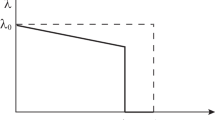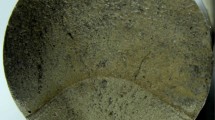In the case of cyclic loading of aircraft structures, fatigue cracks are initiated and grow in riveted joints, which may lead to a decrease in the residual strength and to the sudden widespread fatigue damage. This phenomenon is induced by multiple-site damage, which is usually described by statistical methods. Since the crack length in multiple-site damage is bounded by the distance between the neighboring holes, it is necessary (for the prediction of the limit state in a row of rivets) to know the size distribution of fatigue cracks, which can be computed according to the distribution of operating times (i.e., the numbers of flight cycles) to fatigue-crack initiation with regard for the dependence of crack length on the number of flight cycles. We deduce a relation for the distribution of crack lengths for a given number of flights of an actual aircraft structure. With the use of the numerical values of the parameters of defect initiation and growth, we show that this distribution can be approximated by a hyperbolic-type power function.



Similar content being viewed by others
References
A Method for the Verification of Correspondence to AP 25.571 “Provision of the Safety of Structures by the Conditions of Strength for Long-Term Operation ” [in Russian], Mintrans, Moscow (1996).
Aviation Rules. Norms of Flightworthiness for the Aircrafts of the Transport Category [in Russian], Part 25, Gromov Flying-Res. Inst., Moscow (1994).
Recommendations for Regulatory Action to Prevent Widespread Fatigue Damage in the Commercial Airplane Fleet: A Report of the AAWG (Final Report), Airworthiness Assurance Working Group (1999). Access mode: http://www.faa.gov/aircraft/air_cert/design_approvals/transport/aging_aircraft/media/ARAC_WFDFinalReport399A.pdf
C. Boller, “Structural health management of aging aircraft and other infrastructure,” in: Monogr. on Structural Health Monitoring, Institute of Smart Structures and Systems (ISSS), Bangalore, India (2002), pp. 1–59. Access mode: http://www.shef.ac.uk/content/1/c6/06/05/89/Boller_Monogram[1].pdf
A. Rambalakos and G. Deodatis, “Nonperiodic inspection of aging aircraft structures,” in: Proc. 9th Joint FAA/DoD/NASA Conf. Aging Aircraft (Atlanta, Ga, March 6–9, 2006), pp. 1 − 18. Access mode: http://www.ewp.rpi.edu/hartford/~ernesto/S2007/SMRE/Zpapers/Rambalakos.pdf
A. Kebir, J. M. Roelandt, and J. W. Gaudin, “Monte-Carlo simulations of life expectancy using the dual boundary element method,” Eng. Fract. Mech., 68, No. 12, 1371–1384 (2001).
C. Proppe, “Probabilistic analysis of multi-site damage in aircraft fuselages,” Comput. Mech., 30, 323–329 (2003).
A. N. Garcia, A. W. S. Mello, Jr., and P. E. Irving, “Simplifying MSD modeling by using continuing damage assumption and parametric study: the role of rivet squeeze force,” in: Proc. 26th Congr. Int. Council Aeronaut. Sci. (Anchorage, Al, Sept. 14–19, 2008), P. ICAS 2008-9.8.1. Access mode: http://www.icas.org/ICAS_ARCHIVE_CD1998-2010/ICAS2008/PAPERS/521.PDF
P. White, Review of Methods and Approaches for the Structural Risk Assessment of Aircraft (Technical Report), Air Vehicles Division Defense Science and Technology Organization, DSTO – TR – 1916 (2006). Access mode: http://www.dtic.mil/cgi-bin/GetTRDoc?AD=ada462955
S. R. Ignatovich, “Distribution of defect sizes under loading,” Probl. Prochn., No. 9, 40–45 (1990).
S. R. Ignatovich and F. F. Ninasivincha Soto, “Stochastic model for the formation of inhomogeneities of the sizes of diffused cracks. Part 1. Stationary crack growth,” Probl. Prochn., No. 3, 104–113 (1999).
A. Carpinteri, G. Lacidogna, and S. Puzzi, “Prediction of crack propagation in full-scale structures based on the analysis of the parameter b and the Yule statistics,” Fiz. Mezomekh., 11, No. 3, 75–87 (2008).
Author information
Authors and Affiliations
Corresponding author
Additional information
Translated from Fizyko-Khimichna Mekhanika Materialiv, Vol. 49, No. 2, pp. 109–115, March–April, 2013.
Rights and permissions
About this article
Cite this article
Ignatovich, S.R., Karan, E.V. & Krasnopol’skii, V.S. Probability Distribution of the Lengths of Fatigue Cracks in Riveted Joints of an Aircraft. Mater Sci 49, 257–263 (2013). https://doi.org/10.1007/s11003-013-9608-0
Received:
Published:
Issue Date:
DOI: https://doi.org/10.1007/s11003-013-9608-0




